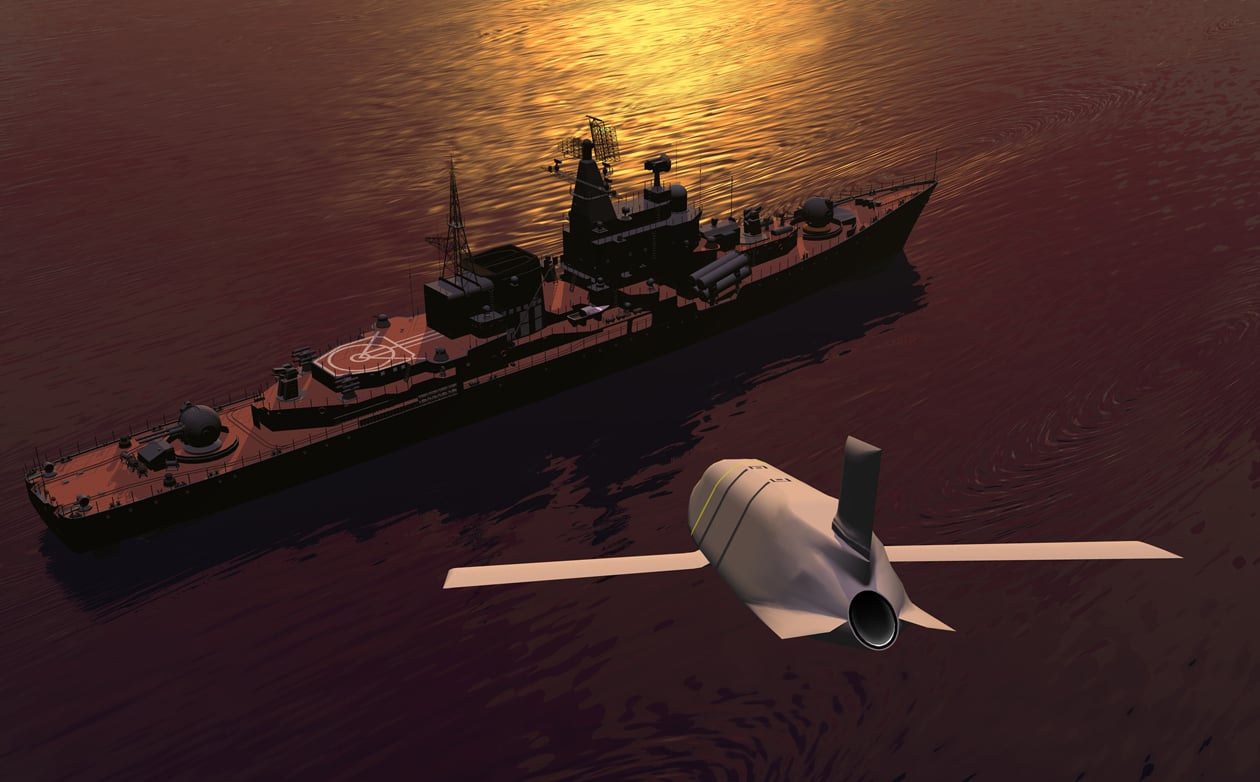
An artist’s depiction of an LRASM (Long-Range Anti-Ship Missile) hurtling towards its target.
PENTAGON: The Navy plans to launch long-range, ship killing missiles from its premiere submarine-hunting aircraft, a clear signal the Pentagon is looking for new ways to meet the tyranny of distance in the Pacific theater.
The plan calls for the Long-Range Anti-Ship Missile (LRASM), a precision weapon equipped with an 1,000-lb warhead able to stealthily penetrate enemy missile defenses, to be fitted on a Poseidon P-8 aircraft. The LRASM, which passed tests on the F-18 Hornet last fall, has a range disclosed only as over 200 miles, but likely can go much further.
The workhorse P-8 already carries torpedos, Harpoon missiles, and the SLAM land-attack munition, but the Navy wants to add LRASMs along with the Joint Direct Attack Munition, the Small Diameter Bomb, and other weapons to its arsenal to give it more punch, at a greater distance.
According to a solicitation posted Monday, the Navy doesn’t expect work to be complete refitting the P-8 until 2026. But the effort reflects the growing concern within the military about Chinese naval capabilities and rapid advances in standoff weapons which could force US forces to stay further away from targets, making plans to come to the defense of US bases in Japan, Guam and elsewhere vastly more difficult.
LRASM is designed to detect and destroy specific targets operating within groups of ships by identifying the target using links to drones or aircraft. An air-launched variant has been successfully tested aboard the Air Force’s B-1 bomber and the Navy’s F/A-18 Super Hornet. Contractor Lockheed Martin has also test-fired LRASM from the same Vertical Launch System tubes used on Navy cruisers and destroyers.
Over the last handful of years, the Pentagon has made a concerted effort to get its ship-killing ability back, first under Obama’s last Defense Secretary Ash Carter and his deputy Bob Work — part of what they called the Third Offset Strategy — later rebranded as “lethality” under Defense Secretary Jim Mattis.
Capt. Will Hargreaves, LRASM program director, wouldn’t comment on a timeline for getting the weapon on the P-8, but said in an emailed statement his office continues to look for ways to use existing platforms to perform new missions, and “flexibility through platform integration remains a viable and cost effective method to achieve those goals.”
The LRASM has much greater range than the Standoff Land Attack Missile-Expanded Response (SLAM-ER), which can travel 135 nautical miles, and the Harpoon, which can hit targets about 70 nautical miles away.
The scope of the problem in the Pacific was underscored in a new report from the Naval War College released Monday.
The new Chinese Type 055 destroyer carries 112 VLS cells capable of launching a range of precision, long-range missiles, a significant growth over its predecessor, the Type 052D, which has just 64.
The new class of destroyer “will significantly enhance China’s long-range striking power,” the report states, predicting that “the commissioning of the first Type 055 in January 2020 may represent a Dreadnought (1906) or even Bismarck (1939) type moment. The launching of these two famous ships dramatically altered the naval strategy landscape in their day. The same might well be said a few decades hence regarding the advent of Type 055.”
With advancements like this in mind, the Navy will also begin arming its attack submarines with ship-killer missiles for the first time in decades, using an updated model of the decades-old Harpoon.
In late 2018, the Navy entered into negotiations with Boeing to refurbish Harpoon anti-ship missiles for Los Angeles-class subs. It’s a major shift after decades in which submarines focused on the mission of projecting power ashore by quietly collecting intelligence or launching Tomahawk Land-Attack Missiles at targets in Iraq, Afghanistan and Syria.
The service is also looking to put long-range missiles on surface ships. Vice Adm. Thomas Rowden, commander of Naval Surface Forces, said last month at a conference that putting over-the-horizon missiles on ships gives the fleet more punch — at greater range — at a time when China is rapidly modernizing its own navy. He wants to do that “by continuing to modify existing over-the-horizon surface weapons by expanding procurement of improved anti-ship, anti-air antisubmarine and surface strike missiles,” including the Harpoon, Naval Strike Missile or Long-Range Anti-Ship Missile.
Navy jet trainer fleet operations remain paused after engine mishap
One week after the incident, a Navy spokesperson says the service is continuing to assess the fleet’s ability to safely resume flight.


























